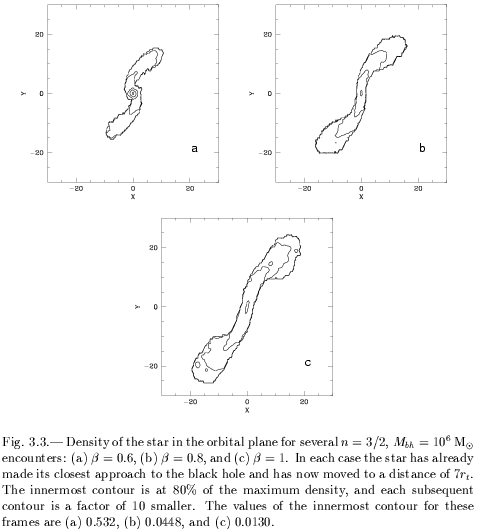Tidal disruption of a star by a massive
black hole
An extreme case of "stellar collision" is the tidal disruption (or,
more generally, interaction) of a star with a massive black hole
(MBH) , i.e. a black with a mass in excess of 1e5 M_sun (Hills
1975, Lidskii
& Ozernoi 1979, Rees
1988). If the MBH is more massive than a few 1e8 M_sun, a MS star
can cross the horizon without disruption. Such tidal disruptions are
of great interest in the dynamics of galactic nuclei.
Tidal disruptions at a rate of order 1e-4 per year and per galactic
nucleus seem unavoidable, with the likely consequence of bringing back
to active life an otherwise quiescent galactic nucleus (Phinney
1989, Sembay
& West 1993, Magorrian
& Tremaine 1999, Syer
& Ulmer 1999). Some flaring events in the UV or X-ray band
from the center of active and non-active galaxies have been tentatively
interpreted as the accretional aftermath of tidal disruptions (Li,
Narayan & Menou 2002, Komossa 2002).
Tidal disruptions may also contribute to the feeding of the central BH
in active galactic nuclei (Young,
Shields & Wheeler 1977, McMillan,
Lightman & Cohn 1981, Duncan
& Shapiro 1983, Durisen & Cohn 1987a,1987b,Murphy,
Cohn & Durisen 1991, Freitag
& Benz 2002).
The process of tidal disruption and the ensuing evolution of the gas
stream has be the subject of many simulations, realized with the SPH scheme, grid hydrodynamics or simplified
1-D
methods that treat the deformed star as a set of ellipsoids. Here is an
incomplete list of these works:
Carter & Luminet
1982,
1983:
Semi-analytical model. Propose that high tidal compression may lead to
thermonuclear detonation of the star in deep encounters.
Nolthenius
& Katz 1982: First SPH simulations of the tidal encounter
between a star and a massive BH; very low resolution.
Bicknell
& Gingold 1983: SPH simulation of the tidal disruption => no
thermonuclear detonation.
Evans
& Kochanek 1986: SPH simulation of the disruption and
discussion of the fate of the debris.
Khokhlov,
Novikov & Pethick 1993a,
Khokhlov,
Novikov & Pethick 1993b: Eulerian grid simulations of weak and
strong tidal interactions. Strong squeezing (
à la Carter & Luminet)
found.
Laguna
et al. 1993: SPH disruption simulation with GR effects. Central
temperature rise not sufficient for detonation.
Frolov
et al. 1994: Grid simulations of the interaction between a 1e4-1e5
M_sun BH and a white dwarf.
Fulbright 1996:
SPH simulation of the disruption with spheroidal kernels. Central
temperature increase closer to Carter & Luminet's prediction (so,
what about detonation?).
Marck,
Lioure & Bonazzola 1996: Pseudo-spectral method with adaptative
mesh allowing for (relatively) fast 3-D hydro computations.
Diener
at al. 1997: Eulerian grid simulations of tidal stripping of a
n=1.5 polytrope by a Kerr BH. Comprehensive coverage of orbital
parameters.
A coherent picture of the tidal disruption itself (at first pericenter
passage) emerges from these works. However, a comprehensive set of
simulations, using realistic models (instead of polytropes) for MS and
Giant stars, and considering various rotation parameters for the BH and
various orbits in a Kerr potential, is still lacking. Also the question
of the possibility of thermonuclear detonation of the star remains to
be
elucidated.
Furthermore, the evolution of the liberated gas is a very intricate
problem, still poorly understood. About one half of the stellar gas is
left bound to the BH. After one orbit, the leading tip of the bound gas
stream will collide with the trailing part (Kochanek
1994, Lee,
Kang & Ryu 1996, Lee
& Kim 1996, Kim,
Park & Lee 1999, Ayal,
Livio & Piran 2000). An accretion disk or a spherical gaseous
envelope will forme around the BH (Cannizzo,
Lee & Goodman 1990, Loeb
& Ulmer 1997, Ulmer,
Paczynski & Goodman 1998, Ulmer
1999, Menou
& Quataert 2001). Obviously, a better understanding of the
post-disruption accretion process in order to predict its observational
signature (wavelength, intensity, duration, etc.). Watch for the work of
Tamara Bogdanovic in this field (Bogdanovic et al. 2004)...
The prompt X-ray and gravitational wave emission at the moment of tidal
disruption (firt pericenter pasage) have been considered by Kobayashi et al. (2004).
Also some more comprehensive set of simulations, using realistic models
(instead of polytropes) for MS and Giant stars would be very welcome.
Even if a star does not penetrate deep enough into the BH's potential
to be completely disrupted, it may be perturbed by the tidal field in
such a way as to present tell-tale observational features. Such
possibilities have been addressed in the following works:
Here, computations of the stellar
evolution of tidally perturbed stars are clearly called for.
Unfortunately, the problem is compounded with the further orbital
evolution of the star and its subsequent tidal interactions with the
BH.
It can thus be considered as an extreme case of binary evolution
problem
(See
Modest
working
group 2).
 Figure from Fulbright's thesis
Figure from Fulbright's thesis